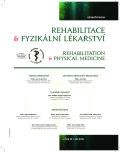-
Medical journals
- Career
Evaluating Electric Activity of Upper Fibers after Application of Various Kinds of Kinesiotaping and Physical Therapy
Authors: R. Orenčák 1,2; M. Janičko 3; Ž. Macejová 3; M. Kasaková 1
Authors‘ workplace: REHAPRO, Michalovce 1; Helios Klinik Aue, Klinik für Neurologie und Stroke Unit 2; I. Interná klinika UNLP, Košice 3
Published in: Rehabil. fyz. Lék., 23, 2016, No. 3, pp. 162-167.
Category: Original Papers
Overview
Background:
Myofascial pain syndrome belongs to most frequent musculoskeletal disordersObjective:
Evaluating the effectiveness of five therapeutic procedures in the treatment of myofascial syndrome of the nucha region syndrome.Cohort and methods:
fifty patients suffering from the nucha pains for at least six weeks were enrolled in the study. The exclude g criteria included severe discopathies with extinction or irritation symptomatology, inflammation and oncological diseases, myelopathies, instability and diseases of the central motoneuron.
Electric activity of upper fiber of the trapezoid muscle was monitored by bilateral surface electromyography in three different positions for the period of 20 seconds and after therapeutic intervention. The comparison of findings before and after the intervention in each patient was evaluated by paired t-test at the p<0.05 level of significance. Subsequently, the percent representation of significant results was assessed in every therapeutic group. The criterion of successful intervention was set for every examination position, if at least 70% of patients reached a significant decrease of electric activity. The calculation of arithmetic mean in one therapeutic group established the mean value of the treatment effect irrespective of the examination position.Results:
In evaluating the various examination positions, as well as in determining the mean value for every method, the best results were provided by the PIR method (represented three times in the evaluation of success according to localization, the mean value being 60% of significantly improved patients, p<0.05). The limit of 70% according to localization was surpassed by the DNS method and thermal therapy, whereas manual techniques and AGR did not reach the value in any case. In averaging the values, the intervention success of thermal therapy reached 59%, manual techniques 52% and AGR reached 39%.Conclusion:
The results made it clear that even a 10-minute therapeutic intervention can significantly influence electric activity of the trapezoid muscle in 39 % to 60 % in relation to the selected method. It confirmed unequivocally the significance of autotherapy practices in a common life of patients and, particularly, their inclusion into the working environment. The PIR method proved to reach the most considerable progress.Keywords:
myofascial pain syndrome, kinesiotherapy, kinesiotaping, surface electromyography, trapezoid muscle, autotherapy practices
Sources
1. DEENEY, C., O‘SULLIVAN, L.: Work related psychosocial risks and musculoskeletal disorders: potential risk factors, causation and evaluation methods. Work, 34, 2009, 2, s. 239-248.
2. EMARY, P.: Use of post-isometric relaxation in the chiropractic management of a 55-year-old man with cervical radiculopathy. J. Can. Chiropr. Assoc., 56, 2012, 1, s. 9-17.
3. FACCI, L. M., NOWOTNY, J. P., TORMEM, F., TREVISANI, V. F.: Effects of transcutaneous electrical nerve stimulation (TENS) and interferential currents (IFC) in patients with nonspecific chronic low back pain: randomized clinical trial. Sao Paulo Med. J., 129, 4, s. 206-216.
4. KIM, S. A., OH, K. Y., CHOI, W. H., KIM, I. K.: Ischemic compression after trigger point injection affect the treatment of myofascial trigger points. Ann. Rehabil. Med., 37, 2013, 4, s. 541-546.
5. LEWIT, K., SIMONS, D. G.: Myofascial pain: relief by post-isometric relaxation. Arch. Phys. Med. Rehabil., 65, 1984, 8, s. 452-456.
6. LIDEGAARD, M., JENSEN, R. B., ANDERSEN, C. H., ZEBIS, M. K. et al.: Effect of brief daily resistance training on occupational neck/shoulder muscle activity in office workers with chronic pain: randomized controlled trial. Biomed. Res. Int., 2013, s. 262-386.
7. SHAMBAUGH, P.: Changes in electrical activity in muscles resulting from chiropractic adjustment: a pilot study. J. Manipulative Physiol. Ther., 10, 1987, 6, s. 300-304.
8. STAAL, J. B., DE BIE, R. A., HENDRIKS, E. J.: Aetiology and management of work-related upper extremity disorders. Best Pract. Res. Clin. .Rheumatol., 21, 2007, 1, s. 123-133.
9. VÉLE, F.: Kineziologie. 2. rozšírene a prepracované vyd., Edtion ed. Praha, Triton, 2006, 375 s., ISBN 80-7254-837.
10. WESTGAARD, R. H.: Muscle activity as a releasing factor for pain in the shoulder and neck. Cephalalgia, 25, 1999, Suppl. 19, s. 1-8.
Labels
Physiotherapist, university degree Rehabilitation Sports medicine
Article was published inRehabilitation & Physical Medicine

2016 Issue 3-
All articles in this issue
- Physical Activity and Cancer
- Autonomous Reactivity in Patients with Ischemic Heart Disease After Aortocoronary Bypass before Cardiac Rehabilitation
- Clinical Study of Applied High-induction Electromagnetic Field on Painful Conditions
- Strategies and Mechanisms Affection of Postural Stability
- Functional State of Foot Arches and Deep Stabilization System of Trunk at Girls Racing Sports Aerobics
- Evaluating Electric Activity of Upper Fibers after Application of Various Kinds of Kinesiotaping and Physical Therapy
- Hippotherapy and Its Use in Rehabilitation
- Rehabilitation & Physical Medicine
- Journal archive
- Current issue
- Online only
- About the journal
Most read in this issue- Hippotherapy and Its Use in Rehabilitation
- Clinical Study of Applied High-induction Electromagnetic Field on Painful Conditions
- Strategies and Mechanisms Affection of Postural Stability
- Functional State of Foot Arches and Deep Stabilization System of Trunk at Girls Racing Sports Aerobics
Login#ADS_BOTTOM_SCRIPTS#Forgotten passwordEnter the email address that you registered with. We will send you instructions on how to set a new password.
- Career

